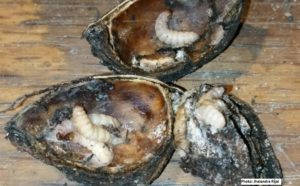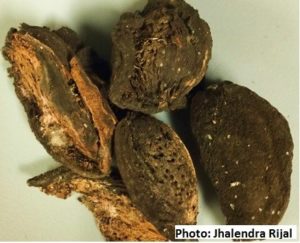
This year has been a challenging year to conduct any winter cultural practices due to constant rainstorms and flood situations. By now, however, mummy nut removal from the trees and ground should have been completed. Orchard sanitation is a very effective cultural method to control navel orangeworm (NOW) in nut crops. Almond mummies not only harbor overwintering larvae (Fig. 1), but also serve as the resource for egg laying (Fig. 2) by NOW females in the spring, during which new nuts are not yet vulnerable to NOW infestation.
For insect monitoring in almonds, we already passed the trap placement timing (February 15) for Oriental fruit moth (remember the biofix of OFM was February 16 last year). Put navel orangeworm egg traps out by March 15 (South San Joaquin Valley) or by April 1 (North San Joaquin and Sacramento Valleys). Use black egg traps filled with the almond meal + 10% crude almond oil. Hang the traps at head height on the north side of the Nonpareil tree, at least 5 trees in from the edge. Put one trap per 10 acres with at least 4 traps per orchard. Remember to change the bait frequently as wet and lumpy bait is not effective in attracting females for egg laying. The biofix of NOW egg laying was April 18 last year. Follow the link for the details.

Pheromone traps and lures are available to monitor male NOW activity. Although the relationship between egg and pheromone traps has not been fully understood, pheromone trap capture data still helps in making NOW control decision. In the orchard with NOW mating disruption, use of the pheromone trap is strongly recommended to assess whether the mating disruption is working. Negligible to no moth capture is expected if the mating disruption is working properly. For San Jose scale, traps should have been placed traps by March 1. For peach twig borer, the time to put the traps out is mid-March (2016 biofix was on 28 March). Follow this link to learn more about how and when to set up traps and monitor San Jose scale and peach twig borer.
Leaffooted bug (LFB) may not be a big issue in every orchard every year, but when they occur, the damage impact can be severe. The LFB adults overwinter in the orchard and other host plants outside the orchard. Adults of LFB move to the orchard during March-April and attack young nuts. Early infestation on nuts before the shell hardening causes aborted nuts, internal gumming and staining nut shells. Feeding on the young nuts may lead to significant nut drops. Late-season infestation (after shell hardening) results in stained nuts and deformed nutmeats. Stink bug attacks can produce similar signs on nuts, including nut drops, but this will happen later in the season (May-June), compared to March-April as in the case of LFB. Don’t get confused the signs of the true bug (i.e. stink bug, and LFB) feeding damage (clear discharge from the nut) with the bacterial spot infection (amber color discharge). A nice comparison of LFB v/s bacterial spot and anthracnose was written in a previous article – click here. Sometimes, other physiological causes gummosis with a clear discharge. In these cases, when the nut is cut, there should not be any signs of LFB feeding. Unfortunately, we don’t have a specific trap/lure to monitor LFB activity in the orchard. Thus, regular scouting in the orchard to look for eggs, live bugs and dropped nuts, are the ways to detect the presence of leaffooted bugs in the orchard. Almond varieties with softer shells such as Fritz, Sonora, Aldrich, Livingston, Monterey, and Peerless are more susceptible to LFB damage.
For spider mites and their predators, start monitoring orchards biweekly from March-May, and weekly after that. Early damage is indicated by the lightly stippled leaves () likely seen in the lower and interior portion of the tree canopy. Take a minimum of 75 leaves from 5 random trees and inspect the leaves using hand lens for the presence of mites and mite predators (No need to count the eggs and mites). Sampling before July 1 should focus on ‘hot spots’ of the orchard (i.e., area near to the dirt roads, weak trees, and edges). Follow the sampling guidelines for details.
Ant colony survey begins in June in the upper San Joaquin Valley and April-May in the lower San Joaquin Valley. Select five locations within the orchard (~1000 sq. ft. per location). Count a total number of ant colonies from the sampled area and compare it with the Table 2 to estimate the potential nut damage at harvest. The longer the nuts remain on the ground after the harvest, the more damage you can expect.
| Table 1. Timeline to deploy traps in almond orchard | ||||
| Insect species | Trap placement date | 2016 Biofix dates
(Modesto area) |
Purpose | |
| Navel orangeworm (eggs) | April 1 | April 18 | Determine biofix and hull-split spray timing | |
| Navel orangeworm (pheromone and/or kairomone) | March 15 | March 28, first moth catch
(this is not the biofix) |
Follow seasonal moth flight activity which can help to properly time spray; deploying pheromone trap is critical for mating disrupted orchards | |
| Oriental fruit moth | February 15 | February 16 (1st biofix)
April 28 (2nd biofix) June 9 (3rd biofix) July 14 (4th biofix) |
Determine biofix and spray timing; monitoring needed only in orchards with a history of damage | |
| Peach twig borer | March 20 | 28 March (1st biofix)
2 June (2nd biofix) 11 July (3rd biofix) |
Set biofix for each generation and determine may spray timings | |
| San Jose scale | February 25
(SJ Valley) March 1 (Sac. Valley) |
– |
Determine biofix, and monitor scale parasites (i.e., Aphytes spp., Encarsia spp.) | |
| Obliquebanded leafroller
Fruitree leafroller |
Apr. 1 | April 12
(biofix for OBLR) |
Determine biofix; monitoring needed only in orchards with history of leafroller damage | |
| Modified from: Almond UC IPM Guidelines | ||||
| Table 2. Percent damage by ants to almonds on ground in an almond orchard | |||||
| No. of colony entrances per 5,000 sq. ft. in spring | Days nuts are on ground | ||||
| 4 | 7 | 10 | 14 | 21 | |
| 15 | 0.9% | 1.6% | 2.1% | 3.1% | 4.9% |
| 45 | 1.4% | 2.3% | 3.2% | 4.7% | 7.0% |
| 185 | 2.0% | 3.6% | 5.0% | 7.0% | 11.1% |
| Source: UCIPM Guidelines | |||||


Almond Assassins! – An Amateur's Adventure with Almonds
May 17, 2018[…] https://thealmonddoctor.com/2017/03/22/seasonal-insect-pest-monitoring-in-almonds/ […]